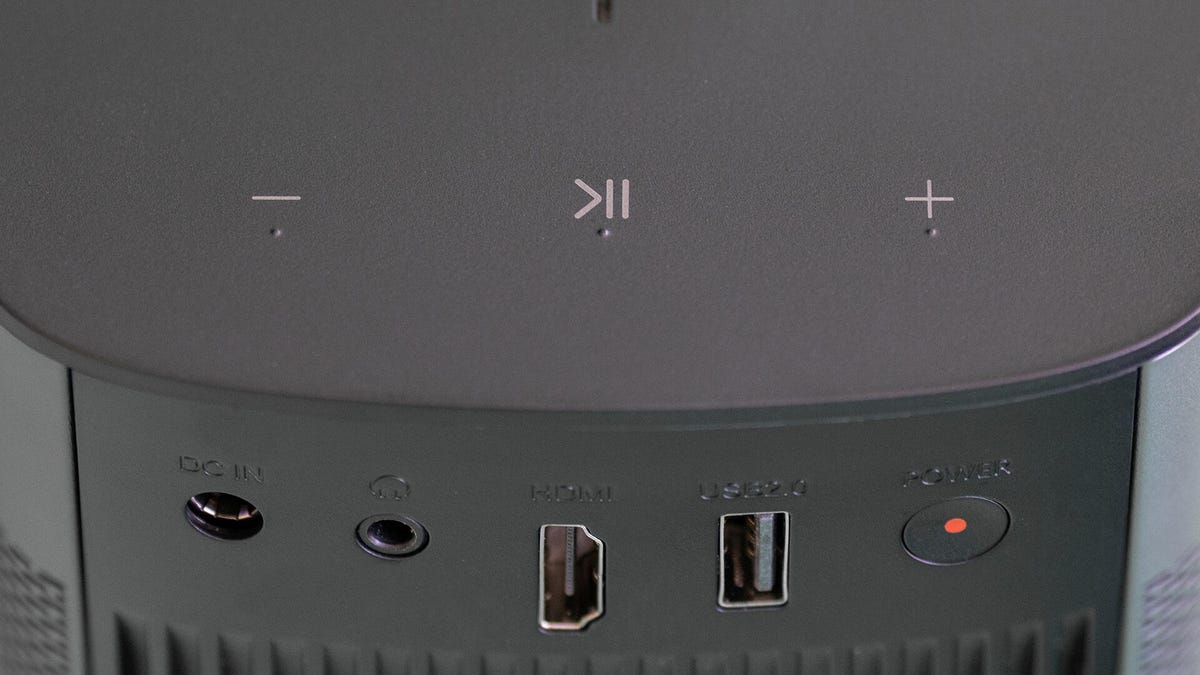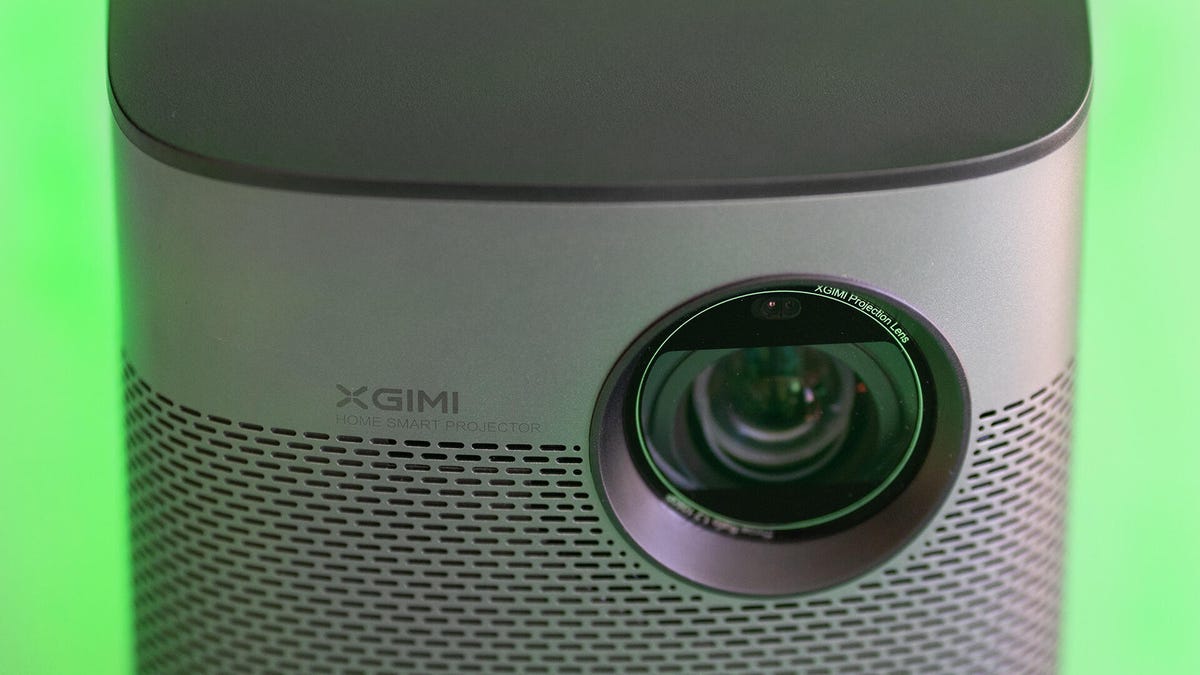The Xgimi Halo Plus is not your typical dim, inexpensive portable mini projector. Its sleek, understated design combines with a surprisingly good picture. This little beauty is bright for its size, has decent contrast, fairly accurate color and Android TV streaming built in. There’s even a battery with 2.5 hours of claimed playback time.
Like
- Bright for the category
- Small size
- Built-in battery
Don’t Like
- A bit expensive
- Color is only OK
- Some weird ergonomics
It’s a bit expensive, however, and easily outclassed by bigger projectors that lack a battery, like the BenQ HT2050A. So if you don’t absolutely need totally cordless movie nights, you can get a better image, or save money, compared to the Halo Plus.
If you are looking for some wireless fun, the Halo Plus offers a better, brighter image than many competing projectors. The simplicity of the built-in Android TV interface and its myriad streaming options makes it far easier to use than many previous portable projectors we’ve liked. You’ll have to pay quite a bit for that ease of use and performance though.
Check Out Classy and Portable Xgimi Halo Plus Projector
See all photos
1080p resolution in a tiny box
- Native resolution: 1,920×1,080 pixels
- HDR-compatible: Yes
- 4K-compatible: Yes
- 3D-compatible: Yes
- Lumens spec: 900
- Zoom: No
- Lens shift: No
- LED life: 25,000 hours
The Halo Plus is a 1080p projector, but it can accept 4K and HDR signals. Like most projectors it won’t do much with HDR, but that functionality doesn’t hurt. As is typical for projectors in this category, there’s no lens shift or zoom. If you want a bigger image, you have to move the projector farther from the screen.
The brightness spec is inflated even more than usual. I measured approximately 284 lumens compared to their spec of 900. That’s not actually that bad, but it’s pretty far from Xgimi’s claims. It’s one of the brighter portable projectors we’ve tested, but a far cry from even less expensive non-battery projectors. So it all depends how you’re approaching the Halo Plus. If the inclusion of a battery is paramount, then this is pretty bright for its class. If you just want something small and not too expensive, there are other, far brighter/better options.
There’s a small foot on the bottom that lets you pivot the front upward to better position the image.
Geoff Morrison/CNET
That battery has a claimed runtime of 2.5 hours. Using the battery drops the light output roughly in half, which is similar to what happens with most battery-powered PJs.
There is one other oddity I have to mention, because it drove me bonkers. When you turn the Halo Plus off you’re given two choices, essentially standby and fully off. If you choose fully off, which is logical if you don’t want the battery to wear down, the only way to turn the projector back on is to press the power button… twice. There’s a tiny warning about this before the screen goes black, but it’s blink-and-miss-it. To me this design is exceptionally counterintuitive. I can’t think of another product that requires you to press the power button twice to activate. I’d seriously thought the projector had died on me mid-review.
Inputs and streaming: Check and check

Geoff Morrison/CNET
- HDMI inputs: 1
- USB port: 1
- Audio output: Headphone output and Bluetooth
- Internet: 2.4/5GHz, 802.11a/b/g/n/ac
- Remote: Not backlit
On the back is a fairly standard suite of connections for a projector this size. HDMI and USB, plus an analog headphone output.
You’ve got full Android TV inside, which is a nice change from the more common Android-lite and Aptoide store. Which means you’ve got all the major streaming apps, and the full versions of said apps. Many portable projectors use nerfed versions of many apps, making them far more annoying to use.
On the sides are two 5W speakers tuned by Harman Kardon. They play quite loud for their size. This is one of the first projectors this size where I didn’t need to run it at 100% to hear over my air conditioner.
Picture quality comparisons

Geoff Morrison/CNET
For my comparison I pitted the Xgimi against two similar (in spirit) portable projectors, the Anker Mars II Pro and the BenQ GS50. The Anker Mars II Pro offers some similar specs, roughly similar size, but is $550. The BenQ has about 80% more physical volume compared to the Xgimi, but both are still easily considered portable. It costs $800. I connected them to a Monoprice 1×4 distribution amplifier and viewed them side by side by side on a 102-inch 1.0-gain screen.
The Anker looked somewhat washed out compared to the Xgimi, despite their contrast ratios being basically the same. This is likely due to the lack of picture setting controls on the Mars II Pro. The non-adjustable brightness setting is too high, raising the shadows and making the image appear washed out. On its own this isn’t as obvious, and the image is still good overall, but compared to the Xgimi it lags behind.
While the Mars II Pro is also 720p to the BenQ and Xgimi’s 1080p, this isn’t quite as big of a deal as you might imagine. Sure, the other two are sharper, but the Anker holds its own. Overall, if you want something that’s nearly as good, but want to save some money, the Mars II Pro is the way to go.

Geoff Morrison/CNET
The GS50 looks good on its own, but there is one vital way it comes up short: brightness. The Xgimi is nearly twice as bright as the BenQ. At 100-inches both are still dim compared to “real” home theater projectors, but if you project a more TV-sized image they look far more impressive. The eye, however, is immediately drawn to the Xgimi. It’s just so much brighter. Its contrast ratio is better too, by about 50%. That, combined with the added light, just makes for a more attractive image.
However, the BenQ has far better color. Grass, skies, skin tones, all look significantly more natural on the BenQ. The Xgimi’s colors aren’t as bad as some I’ve tested lately, they’re just not as realistic as the BenQ’s. While color is a crucial component in overall picture quality, it just can’t compete in this case with the better brightness and contrast ratio of the Xgimi.
What about the Xiaomi Mi Smart Projector 2? I measured half the lumens compared to the Xgimi and Anker, roughly the same as the BenQ. Since it’s basically the same price as the Xgimi, but lacks a battery, the Xgimi is the clear winner.
Silver cylinder

Geoff Morrison/CNET
The Halo Plus has a classy, if understated, design. A business suit on the outside but an athlete on the inside. It performs better than its most direct competitors. However, as with any of these portable projectors, you really need to consider how you’re going to be using it. Is the battery aspect a nice addition, or will you be using it that way regularly? Because if you’re not going to be using the battery a traditional home theater projector like the BenQ HT2050A, for example, looks vastly better than the Halo Plus for the same money.
On the other hand, if you are going to be using it away from power outlets regularly, the Halo Plus offers a brighter, and generally better, image compared to several other portable projectors we’ve liked. The Anker Mars II Pro is a better deal, but lacks the contrast, detail, and the ease of use of a full Android TV interface. The BenQ GS50 has a more playful industrial design, but can’t compete with the Xgimi on brightness.
So if you are going to be using it unplugged, and don’t mind the fairly high price, the Xgimi Halo Plus is a great option.

Geoff Morrison/CNET
Source by www.cnet.com

























